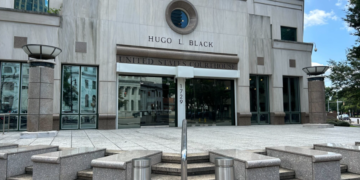August 22, 2025 Story by: Publisher
A federal judge ruled Friday that Alabama’s current state Senate district map violates Section 2 of the Voting Rights Act of 1965, which prohibits voting laws that discriminate based on race. The ruling prohibits the use of the current map in the 2026 elections and requires lawmakers to create an additional majority-Black or near-majority-Black Senate district in the Montgomery region.
In a 261-page opinion in a lawsuit brought against the state by the Alabama State Conference of the NAACP, U.S. District Judge Anna Manasco, appointed by President Donald Trump, stated that to remedy the violation, the Alabama Legislature must create a new Senate district in the Montgomery area.
U.S. District Judge Manasco ruled that Alabama’s state Senate map violates the Voting Rights Act of 1965 (VRA) by unlawfully diminishing the voting strength of Black Alabamians. The ruling prohibits the use of the current map in the 2026 elections and requires lawmakers to create an additional majority-Black or near-majority-Black Senate district in the Montgomery region.
If state legislators fail to act, the court made clear that it will impose its own remedial plan.
The Court’s Findings
Judge Manasco, a Trump appointee, found that the state’s mapmakers packed Black voters into one Montgomery district while cracking adjacent communities to limit their ability to elect candidates of their choice. This practice, the court concluded, violates Section 2 of the VRA, which prohibits election laws or maps that result in the dilution of minority voting power.
The court rejected similar claims about the Huntsville area, finding that plaintiffs had not demonstrated that an additional majority-Black district could be drawn there while meeting legal and geographic requirements.
The ruling stems from a 2021 lawsuit brought by the Alabama State Conference of the NAACP, Greater Birmingham Ministries, and several Black voters, represented by the ACLU, NAACP Legal Defense Fund, and Southern Poverty Law Center.
“This decision proves that when we challenge injustice, we can make progress. Alabama must now draw fairer districts in Montgomery, but let’s be clear—leaving Huntsville untouched still denies many Black Alabamians their rightful representation,” said Benard Simelton, president of the Alabama State Conference of the NAACP.
It was also not immediately clear when maps might be redrawn, should Manasco’s ruling be upheld. A federal court in 2017 ruled that 12 of Alabama’s 105 House districts violated the Voting Rights Act and had to be redrawn. The Legislature did so during that year’s regular session. The Legislature in 2023 drew a new map in a special session; the court rejected the map as unresponsive and ordered its own. Manasco, who ordered new maps be put in place for the 2026 elections, scheduled a status conference for next Thursday.
The plaintiffs claim that the districts in Montgomery and Huntsville dilute Black voting power in the state in violation of the VRA by unconstitutionally packing Black voters into particular districts.
A Pattern of Resistance
This is not the first time federal courts have intervened in Alabama’s redistricting.
- In 2022, a three-judge panel struck down the state’s congressional map for illegally diluting Black voting power, leading to Allen v. Milligan, a case in which the U.S. Supreme Court upheld Section 2 of the VRA. The Court ordered Alabama to create a second majority-Black congressional district.
- In 2023 and 2024, after Alabama defied the order and submitted a noncompliant plan, federal judges appointed a special master who produced a new congressional map. That map was used in the 2024 elections, resulting in the election of two Black representatives: Democrat Terri Sewell in Birmingham and Democrat Shomari Figures in the newly drawn Second District.
- Earlier this year, another federal panel concluded that Alabama had engaged in intentional discrimination when drawing its congressional map, underscoring persistent challenges to compliance.
Background
In a unanimous decision Thursday, August 7, a panel of three district court judges in the Northern District of Alabama issued an injunction to keep in place a congressional map that includes two Black-majority districts through the end of the decade.
The map—crafted by a court-appointed special master—must remain in effect until the next regularly scheduled redistricting in 2030. The court will also retain jurisdiction over the case until the injunction expires.
The panel’s ruling effectively nullifies Alabama’s 2023 congressional map, which had defied earlier court directives by preserving only one Black-majority district despite evidence that a second could be drawn in compliance with the Voting Rights Act (VRA). In their order, the judges underscored that the 2023 map was a clear violation of federal law and prior judicial instructions.
The case was originally brought in November 2021 on behalf of Evan Milligan, Khadidah Stone, Letetia Jackson, Shalela Dowdy, Greater Birmingham Ministries, and the Alabama State Conference of the NAACP who are represented by the American Civil Liberties Union, ACLU of Alabama, Legal Defense Fund, and Wiggins, Childs, Pantazis, Fisher & Goldfarb.
In 2022, a three-judge federal court struck down Alabama’s 2021 map, ruling that it violated Section 2 of the Voting Rights Act by diluting Black voting power.
The court noted that Black Alabamians make up about 27% of the state’s population but under the old plan held only one of seven U.S. House seats (roughly 14% of representation). With voting patterns sharply polarized by race in Alabama, the court concluded that Black voters could not elect their preferred candidates in a second district under the 2021 plan.
The court ordered the state to draw a map with two districts in which Black voters would have a realistic opportunity to elect their chosen candidates.The U.S. Supreme Court upheld that ruling.
In Allen v. Milligan, 599 U.S. (2023), the Court agreed that plaintiffs were likely to prevail on their Section 2 claim against Alabama’s 2021 map. The Court’s 5-4 decision effectively mandated creation of a second majority-Black district.
In response, the Alabama legislature approved a new map in 2023 with one majority-Black district and a second district that was roughly 40% Black. The federal panel, however, still found that map intentionally discriminated against Black voters for failing to produce two Black-opportunity districts as required by law.
When Alabama’s legislature responded with a map that still contained only one such district, the federal court intervened and tasked a special master with producing a compliant map. That remedial map was used in the most recent election cycle and resulted in the election of Representative Shomari Figures, a Democrat, giving Alabama two Black-majority districts for the first time in modern history.
Sources: Alabama Reflector / Alabama Public Radio / AP News / NAACP LDF / Reuters

















